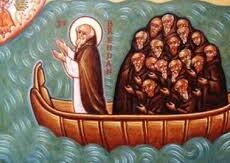
A coffin ship (Irish: long cónra) is an idiom used to describe the ships that carried Irish migrants escaping the Great Irish Famine.
Coffin ships carrying emigrants, crowded and disease-ridden, with poor access to food and water, resulted in the deaths of many people as they crossed the Atlantic, and led to the 1847 North American typhus epidemic at quarantine stations in Canada. Owners of coffin ships provided as little food, water and living space as was legally possible, if they obeyed the law at all. With death rates commonly reaching 20 percent and horror stories of 50 percent dying, these vessels soon became known as coffin ships. Those who died were buried at sea.
While coffin ships were the cheapest way to cross the Atlantic, mortality rates of 30 percent aboard the coffin ships were common. It was said that sharks could be seen following the ships, because so many bodies were thrown overboard.
Legislation to protect emigrant passengers, the Passenger Vessels Act, was first enacted in Britain in 1803 and continued to evolve in the following decades. A revised Act in 1828, for example, marked the first time that the British government took an active interest in emigration matters. Within a few years, regulations were in force to determine the maximum number of passengers that a ship could carry, and to ensure that sufficient food and water be provided for the voyage.
The National Famine Monument at the base of Croagh Patrick in Murrisk, County Mayo, Ireland depicts a coffin ship with skeletons and bones as rigging. Sculpted by John Behan, it is Ireland’s largest bronze sculpture. The “Coffin Ship” was unveiled by then President of Ireland Mary Robinson in 1997 to mark the 150th anniversary of the Irish Famine.
Let me now switch to the personal and relate stories my Great-grandmother told my mother over century ago when she was a young girl living in Ottawa, Canada. It seems that the youngest boy in the O’Connell family died during the voyage and my Great-grandmother couldn’t bear the thought of the lad thrown overboard to the sharks so she paid a member of the crew to sew him up in a sail so he could be buried on land when the ship docked in Boston. It was done before they left Boston for Ottawa. There were many other stories of the crossing that I was told but cannot recall. My message is if you have this sort of tale in your head, write it down and pass it on to your kids before you forget the stories or join those who came before you and have passed.
Mike Eggleston



